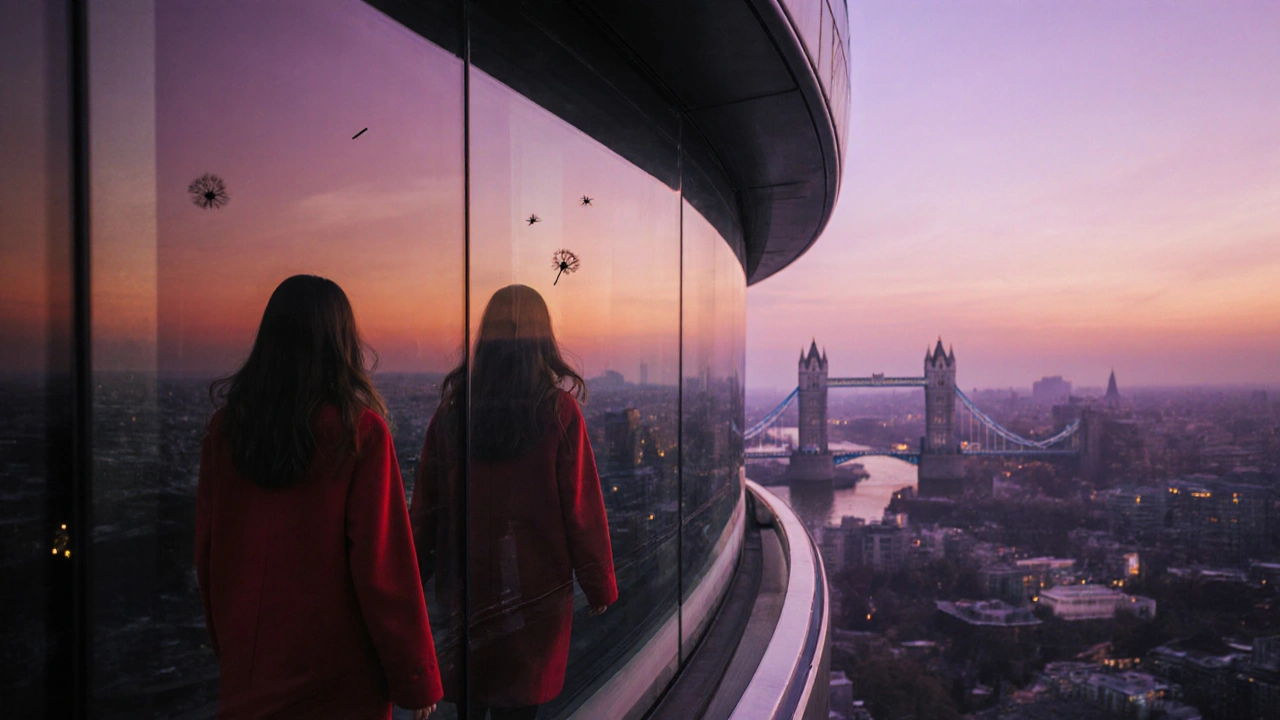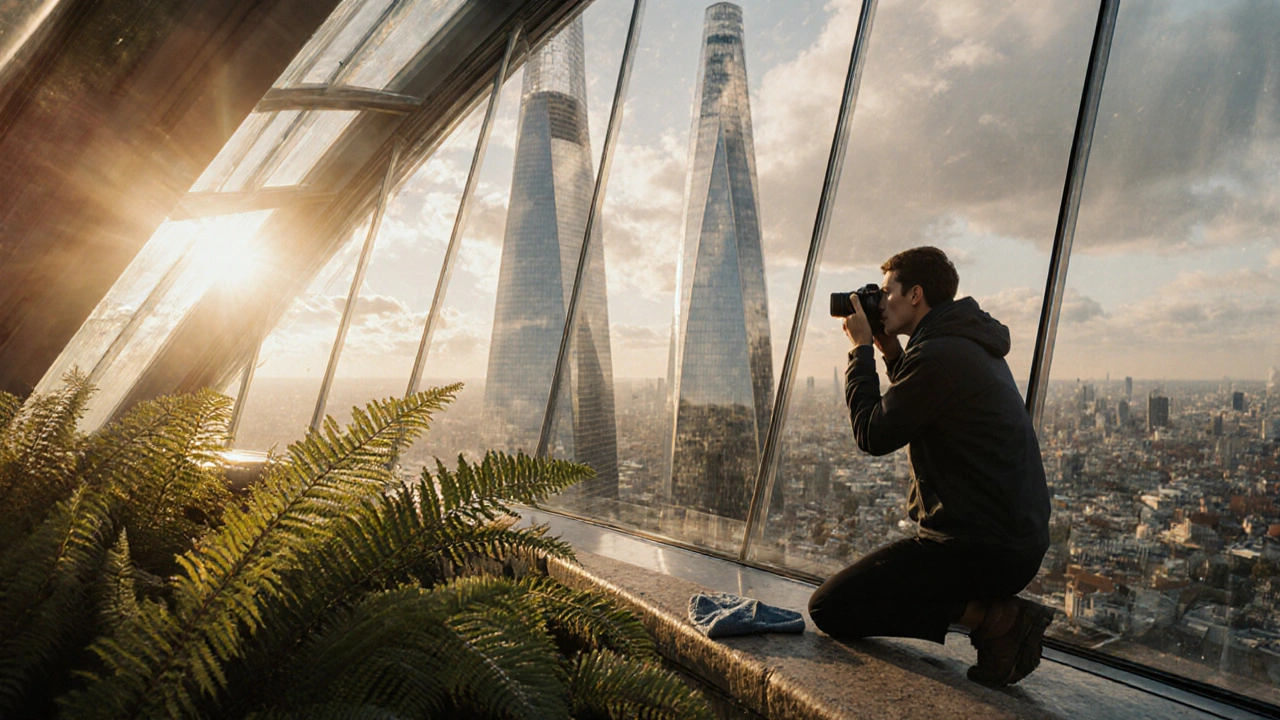Most people walk through Sky Garden in London thinking it’s just a fancy rooftop garden with free entry. They’re wrong. If you’ve ever stood on the 35th floor, looking out over the City of London through that massive glass dome, you know it’s one of the most photogenic spots in the city-no ticket needed, no crowds if you go at the right time.
Why Sky Garden Is a Photographer’s Secret Weapon
Sky Garden isn’t just a garden. It’s a 360-degree viewing platform wrapped in curved glass, 160 meters above ground. The dome lets in natural light that turns midday into a softbox studio. The glass reflects the skyline like a mirror, doubling the drama. And because it’s free (yes, really), you get to shoot here without fighting off tour groups every hour.
Instagrammers love it. But most of them take the same shot: a selfie with the Tower Bridge behind them. If you want photos that stand out, you need to know where to stand, when to shoot, and how to use the glass.
Best Times to Shoot: Light, Crowds, and Weather
Forget sunrise. Sky Garden faces mostly west and north. That means golden hour hits late afternoon-between 4:30 PM and 6:30 PM in November 2025. That’s when the sun glides behind the City’s towers, casting long shadows and warm tones across the glass dome.
Weekdays are your best friends. Friday evenings get busy. Saturdays? Expect lines. Go Tuesday or Wednesday at 3 PM. You’ll have the upper level almost to yourself. Rain? Don’t cancel. Wet glass reflects the city lights like liquid neon. Cloudy days? Even better. Diffused light means no harsh highlights on the glass, and the clouds act like a giant soft filter.
Pro tip: Check the weather app for wind speed. High winds make the glass vibrate slightly, which can blur long exposures. Aim for under 15 mph.
Where to Stand for the Perfect Glass Dome Shot
The dome isn’t one flat surface. It’s three curved sections, each with different angles and reflections. The best spot is near the northern edge, just past the ferns and before the café. That’s where the glass curves inward just enough to create a natural frame around the Shard and the Gherkin.
Hold your camera low-knee height or lower. Tilt up slightly. The glass will mirror the sky and buildings above you, creating a surreal double-exposure effect. Don’t shoot straight ahead. Aim for a 30-degree upward angle. That’s when the dome becomes a halo around the city.
Use a polarizing filter if you have one. It cuts glare on the glass without killing the reflections. If you’re using a phone, tap on the brightest part of the dome to lock exposure. Then drag your finger down to darken it slightly. You’ll bring out details in the clouds and buildings.

35th-Floor Views: Don’t Just Point and Shoot
The view from the 35th floor isn’t just pretty-it’s layered. Closest: the greenery of the garden. Middle: the glass railings and steel beams. Farther: the City’s towers. And beyond that: the Thames and the distant skyline.
Use those layers. Shoot with a wide-angle lens (16-24mm on full frame). Position a plant or railing in the foreground to add depth. The ferns near the east exit make perfect leading lines. Walk toward the south side and shoot through the gap between two pillars. You’ll get the Tower Bridge framed perfectly with the dome’s curve above it.
Try this: Set your camera to aperture f/8. Focus on the railing. Let the buildings blur slightly in the distance. That shallow depth of field makes the city feel like a painting. At dusk, switch to a tripod. Shoot a 10-second exposure. The moving clouds will streak like smoke. The lights of the buildings will glow like embers.
Camera Gear That Actually Works Here
You don’t need a pro setup. But some gear makes a difference.
- Phone users: Use Night Mode at dusk. Hold steady or lean against a pillar. Turn off HDR-it overexposes the glass.
- DSLR/Mirrorless: A 24-70mm lens covers 90% of your needs. Bring a 16-35mm for wide dome shots. A 50mm f/1.8 is great for isolating details like raindrops on glass.
- Tripod: Allowed after 6 PM. Bring one if you’re shooting twilight. No tripods before then-security stops you.
- ND filter: Only useful if you’re shooting in bright daylight and want motion blur on clouds. Rarely needed.
Most people carry their phone and a coffee. That’s fine. But if you’re serious, pack a small microfiber cloth. The glass gets fingerprint-smudged fast. Wipe it before you shoot.
What Not to Do
Don’t use flash. It reflects off the glass like a spotlight on a mirror. You’ll ruin your shot and annoy everyone around you.
Don’t stand directly under the dome’s center. That’s where the skylight is brightest. You’ll blow out the sky and lose all detail.
Don’t assume the view is the same every day. The light changes. The clouds move. The reflection of the Shard looks different on a clear day than on a hazy one. Come back twice. Shoot at 5 PM and again at 7 PM. You’ll get two completely different photos.

Real Examples: What Works
Last month, a local photographer named Lena captured a shot that went viral: a single dandelion seed floating in front of the dome, with the Tower Bridge behind it. She used a 100mm macro lens, shot at f/2.8, and waited 45 minutes for the wind to carry the seed into the right spot.
Another shot: a woman in a red coat walking along the glass edge, her reflection doubling her image. The glass mirrored the sky, making her look like she was floating above the city. She used a 35mm lens, shot at f/5.6, and timed it just as the sun dipped below the horizon.
These aren’t magic. They’re patience and observation.
Final Tip: Shoot Like a Local
Londoners don’t treat Sky Garden like a tourist trap. They come here to read, to eat lunch, to escape the noise. So should you. Walk slowly. Look up. Look down. Look through the glass. Watch how the light moves across the steel beams. Notice how the shadows shift as the sun drops.
Don’t just take photos. Take moments. The best shots aren’t the ones with the most likes. They’re the ones that make you stop and remember how quiet it felt up there, how the wind sounded like it was whispering through the leaves, how the city below looked like a model train set lit by sunset.
Do I need to book a ticket for Sky Garden?
No, entry to Sky Garden is completely free. But you must book a free time slot in advance through their official website. Walk-ins aren’t allowed. Book at least 2-3 days ahead for weekdays, and a week ahead for weekends.
Can I use a tripod at Sky Garden?
Yes-but only after 6 PM. Before that, tripods are not permitted due to crowd safety rules. If you’re shooting at golden hour, plan to stay past 6. Bring a compact, lightweight tripod that fits in a backpack.
What’s the best lens for Sky Garden photos?
A 24-70mm lens is the most versatile for most shooters. For wide dome reflections, use a 16-35mm. For close-up details like raindrops or plants in front of glass, a 50mm or 100mm macro works best. Phone users should stick to the wide-angle lens and avoid digital zoom.
Are there restrooms or cafes at Sky Garden?
Yes. There are two cafes (one on the 35th floor, one on the 36th) and public restrooms near the east exit. The cafes are expensive, but the coffee is good. Bring a snack if you’re planning to stay longer than an hour.
Is Sky Garden open year-round?
Yes, Sky Garden is open every day except Christmas Day. Hours vary by season: usually 10 AM to 10 PM in summer, and 10 AM to 7 PM in winter. Always check their website before you go-events or maintenance can cause temporary closures.
Next Steps: Go Shoot, Then Come Back
Don’t just read this and save it for later. Book your slot. Go on a Tuesday. Arrive at 3 PM. Walk slowly. Look at the glass like it’s a living thing. Take five shots. Then ten. Then twenty. Don’t check your phone until you’re back on the street.
When you do, you’ll realize something: Sky Garden isn’t about the view. It’s about how the city looks when you’re not looking at it directly. The reflections. The shadows. The quiet. That’s what makes the photo real.
